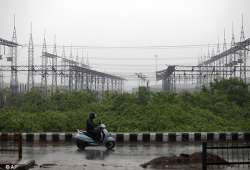Northern Grid had close shave a day before collapse
New Delhi, Aug 2: Hours before a Northern Grid failure pushed a major part of the country into darkness early morning on July 30, electricity transmission lines witnessed a “near miss situation” due to power

New Delhi, Aug 2: Hours before a Northern Grid failure pushed a major part of the country into darkness early morning on July 30, electricity transmission lines witnessed a “near miss situation” due to power overdrawals in parts of Uttar Pradesh and Madhya Pradesh, an internal probe has found.
The Northern Grid, which serves more than 30 crore people across nine regions including the National Capital, had first tripped on July 30 at 0233 hours and then again on July 31 at around 1300 hours.
However, an initial investigation into the matter by PowerGrid subsidiary Power Systems Operation Co Ltd (POSOCO) has found that a prior incident of heavy power flow had led to “a near miss situation” at 1510 hours on July 29 as well.
In the first failure on July 30, “nearly the entire Northern Grid was affected while in the second disturbance (next day), the Northern, Eastern and North Eastern grids were affected to a large extent,” POSOCO has said in its initial report on this power crisis.
“In both the disturbances, in the antecedent grid conditions there was heavy power flow on the 400 kV Bina-Gwalior-Agra single circuit section crossing 1000 MW on the single circuit available,” it said.
While Bina and Gwalior are in Madhya Pradesh, Agra is part of neighbouring state, Uttar Pradesh.
Another circuit on this corridor was already “under outage since July 28 for upgradation to 765 kV level,” it added.
POSOCO further said that a “similar incident at 1510 hours on July 29 had also led to a near miss situation.”
The report said this particular section was taking a load much higher than its limit, while loading on many circuits in the Eastern region was over and above the normal levels.
The report further said various concerns about the system loading have come to the fore in several grid disturbances over the past few years.
These concerns include “surprises in the form of protective relaying mis-operations either due to incorrect settings, load encroachment or use of distance relays for power swing blocking.
“These have led to cascading failures in the past,” it said, while adding that “sustained high loading for a period of ten minutes or more in daytime high ambient temperature conditions have led to line tripping on transient faults possibly due to increase in sag.”
Besides, high reactive power consumption by the transmission line under heavy loading conditions have led to voltage dips in the system and “lack of dynamic reactive power consumption adds to the constraint”.
POSOCO has suggested some immediate corrective measures while the incidents of July 30 and 31 are analysed in detail.
These include review of transfer capability of inter-regional and other links and imposition of congestion charges for any overdrawals.
The government has set up a three-member committee, headed by Central Electricity Authority (CEA) Chairperson A S Bakshi, to look into the grid failure and its report is expected in about a fortnight.
The Northern Grid, which serves more than 30 crore people across nine regions including the National Capital, had first tripped on July 30 at 0233 hours and then again on July 31 at around 1300 hours.
However, an initial investigation into the matter by PowerGrid subsidiary Power Systems Operation Co Ltd (POSOCO) has found that a prior incident of heavy power flow had led to “a near miss situation” at 1510 hours on July 29 as well.
In the first failure on July 30, “nearly the entire Northern Grid was affected while in the second disturbance (next day), the Northern, Eastern and North Eastern grids were affected to a large extent,” POSOCO has said in its initial report on this power crisis.
“In both the disturbances, in the antecedent grid conditions there was heavy power flow on the 400 kV Bina-Gwalior-Agra single circuit section crossing 1000 MW on the single circuit available,” it said.
While Bina and Gwalior are in Madhya Pradesh, Agra is part of neighbouring state, Uttar Pradesh.
Another circuit on this corridor was already “under outage since July 28 for upgradation to 765 kV level,” it added.
POSOCO further said that a “similar incident at 1510 hours on July 29 had also led to a near miss situation.”
The report said this particular section was taking a load much higher than its limit, while loading on many circuits in the Eastern region was over and above the normal levels.
The report further said various concerns about the system loading have come to the fore in several grid disturbances over the past few years.
These concerns include “surprises in the form of protective relaying mis-operations either due to incorrect settings, load encroachment or use of distance relays for power swing blocking.
“These have led to cascading failures in the past,” it said, while adding that “sustained high loading for a period of ten minutes or more in daytime high ambient temperature conditions have led to line tripping on transient faults possibly due to increase in sag.”
Besides, high reactive power consumption by the transmission line under heavy loading conditions have led to voltage dips in the system and “lack of dynamic reactive power consumption adds to the constraint”.
POSOCO has suggested some immediate corrective measures while the incidents of July 30 and 31 are analysed in detail.
These include review of transfer capability of inter-regional and other links and imposition of congestion charges for any overdrawals.
The government has set up a three-member committee, headed by Central Electricity Authority (CEA) Chairperson A S Bakshi, to look into the grid failure and its report is expected in about a fortnight.